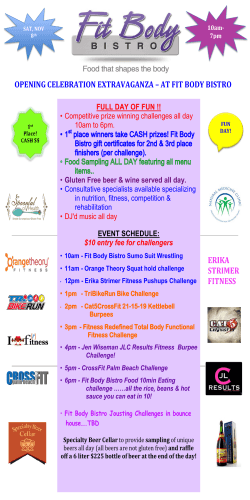
PERSONAL TRAINER CHEAT SHEET Resources to assist with fitness plans.
PERSONAL TRAINER CHEAT SHEET Resources to assist with fitness plans. Created by Dr. Kim Butler Table of Contents • SMART Goals • FITT Principle • Overload Principle • Progression Principle • Specificity • Principle of Recuperation • Principle of Overtraining • 10% Rule • Resources SMART Goals The goals that you establish should take into account your current fitness levels as well as where you want your fitness levels to be. Use “SMART” criteria to set your fitness goals. • SPECIFIC: What do you want to achieve? How will you achieve it? Why is it important? • MEASURABLE: Establish how to measure success: actual numbers target dates, or specific events. • ACHIEVABLE: Your goals should push you past your comfort point but should still be do-able. • RELEVANT : Your goals should be important and the outcome should impact your life. • TIMELY: Your goals should have a time element established. This helps keep you client on track. Example: Specific and Measurable Goals • Make your goals specific and measurable. You need a way to determine if goal has been met. • Avoid unfocused goals, such as, "I want to lose weight by spring break.” Or, “ To lose weight I plan to eat healthy and exercise regularly.” • Establish focused goals instead: "I want to lose 15 pounds by spring break.” Or, “I will exercise 3 times a week for at least 20 minutes and follow the healthy eating plan outlined by my dietitian. With these changes I should lose 1.5 pounds a week for 10 weeks." Example: Realistic Goals • This is the most important rule in goal setting--set goals that you can reach. Consider your current fitness level, consult with your teacher, and write down goals you know you can achieve. Setting goals that are unachievable are likely to frustrate you and may result in giving up on your program. • Establish short-term goals first. Reaching short-term fitness goals will motivate you to continue exercising. • After you reach a short-term goal, pat yourself on the back, and then establish a new one. Example: Long Term Goals Set realistic long-term goals. When setting your long-term goals, take into account your physical limitations and any hereditary factors that may affect your fitness limits. Set goals that are realistic for you and not based on performance scores of other people. Establish lifetime maintenance goals. In addition to shortterm and long-term goals, consider establishing a fitness maintenance goal. The purpose of this goal will be to maintain your new fitness level by remaining physically active. Example: Goal Time Frame Establish a time frame: setting a date for reaching the goal will help you stay focused. For example: By January 15 I will be able to complete 7 perfect push ups. Use a reward system. Reaching a goal is an accomplishment that you should acknowledge with a reward that is meaningful to you. FITT Principle FITT PRINCIPLE • F = Frequency. Describes how often activity takes place in a week (ex: Mon-Wed-Fri). • I = Intensity. Describes how vigorous you are engaged in activity (ex: moderate or vigorous). • T = Type. Describes the specific activity selected (ex: Zumba or Lacrosse). • T = Time. Describes how long the participant is engaged in activity (ex: 30 min cardio, 20 min weights, 10 min stretching). Overload To improve physical fitness, the body or the specific muscle groups used during exercise must be stressed. Describe how you or your client will meet the Overload Principle. Examples: Cardio – jog a little farther without walking. Push ups – lower your body a little more and/or do more push ups. Progression Progression is an extension of the overload principle and states that overload should be increased gradually over the course of a physical fitness training program. As a person’s fitness level improves, he or she will need to make adjustments to the exercise program if continued improvements are desired. Don’t increase load more than 10% per week. Describe how you or your client will meet the progression principle. • Example: Week 1- jog 2 minutes/walk 2 minutes for total of 10 minutes, Week 2- jog 3 minutes/walk 2 minutes for a total of 10 minutes, etc…until able to jog 20 minutes without walking. 10 % Rule The training intensity or duration of exercise should not be increased by more than 10% per week. Example: Mabel is able to jog 10 minutes without stopping. By the end of this week our goal is for Mabel to be able to jog for 11 minutes without stopping. Current Fitness Level (jog 10 minutes) 10 Multiply by 10 % X .10 Maximum amount to increase work load (1 minute) =1 Specificity The principle of specificity means only those body parts, muscles or systems involved in a workout will be the ones to experience training. If you want to improve aerobic capacity you should engage in activities that involve the cardiovascular system. Determine which specific activities you or your client will do to meet fitness goals. Example: if a person swims four times a week to improve fitness, he or she will experience gains in cardiorespiratory (aerobic) endurance, but will not necessarily experience great flexibility benefits, needed to improve performance in yoga class. Principle of Recuperation The body requires recovery periods between exercise training sessions to adapt to the exercise stress. Therefore, a period of rest is essential for achieving maximal benefit from exercise. Good rule of thumb: 3 days on 1 day off. Overtraining The result of failure to get enough rest between exercise training sessions. Symptoms include chronic fatigue, over use injuries, weight loss, and loss of desire to play favorite sports or work out. Resources • Quizlet Flash Cards on Fitness • Scripps My SMART Goals Worksheet • Fitnessgram HFZ Charts
© Copyright 2026


















